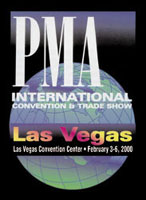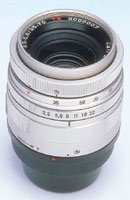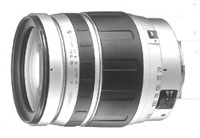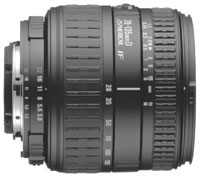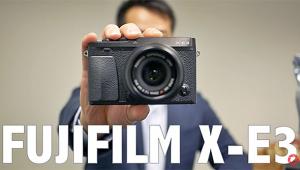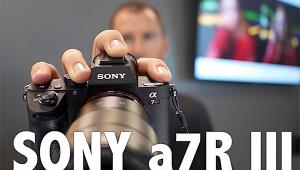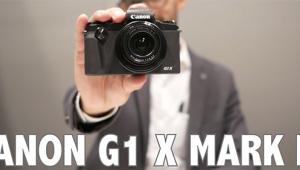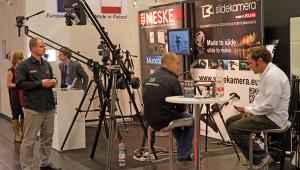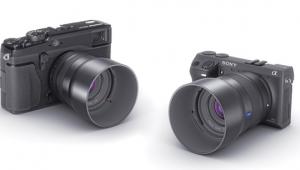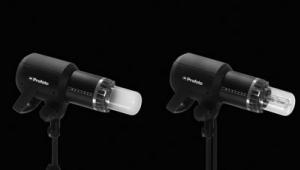Lenses For 35mm Cameras
Next to new SLR cameras, lenses always attract the most attention among those attending the annual PMA show. Although we did not see as many new models this year as last, this was not surprising. Because 2000 is a photokina year, most manufacturers will make their most significant announcements in the fall. Nonetheless, I did find some interesting trends and a few surprises while making the rounds in Las Vegas. Canon. Intended solely for very high-magnification photography, the new MP-E 65mm f/2.8 Macro lens allows for reproduction ratios from 1x (life-size) to 5x (five times life-size) without the need for cumbersome bellows. The distance from the front element to the subject varies, depending on the level of magnification selected: from 4" at 1x to 1.6" at 5x. The optical formula of 10 elements includes one made of UD glass and three group floating elements for high sharpness at all magnifications. A removable tripod-mounting collar is included and the lens accepts the Macro Ring Lite ML-3. |
|
The most popular Canon EF Macro lens ever made, the top rated 100mm model has now been upgraded. The new EF 100mm f/2.8 Macro USM (12 elements in 8 groups) incorporates a ring-type Ultrasonic Motor for fast, silent autofocus with manual focus override at any time. This lens is also said to be the first in its class to use an inner focusing mechanism allowing lens length to remain constant regardless of focused distance. A three group floating system is used for focusing to ensure optimal image quality. The new lens (with 1:1 capability without accessories) is compatible with Canon's EF extension tubes, Macro Ring Light ML-3 and MR-14EX, as well as the optional Tripod Collar B and Lens Hood ET-67. Contax. Anyone who assumed that making a zoom lens for a rangefinder camera was technically impossible, was convinced otherwise on seeing the new 35-70mm f/3.5-5.6 Carl Zeiss Vario-Sonnar T* zoom. Designed for the Contax G system, this lens is fully coupled with the zooming parallax compensating finder of the G2. Its classy titanium/silver finish matches the G2 perfectly. This zoom is compact (2.4" long with 46mm filter size) and lightweight (10 oz) with close focusing down to 39". Mechanically excellent, we also expect it to be optically superb like all of the Carl Zeiss T* lenses for the G series cameras. |
|
Konica. This manufacturer was showing off its three M-mount Hexanon lenses intended for use with their new Hexar RF rangefinder camera. The 50mm f/2 is sold with the camera in a kit and offers a wide aperture for low-light photography. The 90mm f/2.8 is surprisingly light/compact and is said to offer high contrast and exceptional color reproduction. Most notable is the new 28mm f/2.8 wide angle with eight elements, all low-dispersion glass with a high refractive index, intended to produce sharp images with excellent resolution. After examining these lenses, I concluded that all feature exceptional construction and mechanisms, likely to satisfy the discriminating photographer. |
|
Minolta. The Maxxum system already includes a full line of lenses from 17-600mm, so Minolta announced only enhanced models: the stylish silver version of two existing zooms, a perfect match for their latest Maxxum cameras. The AF Zoom 70-210mm f/4.5-5.6II Silver includes the most popular focal lengths and offers close focusing down to 3.6' with a maximum reproduction ratio of 0.26x. An even more versatile model, the AF Zoom 75-300mm f/4.5-5.6II Silver allows for close focusing at any focal length, down to 4.9'. |
|
Nikkor. One of the stars of this year's show, the new AF VR Zoom-Nikkor 80-400mm f/4.5-5.6D ED lens features Nikon's proprietary Vibration Reduction (VR) system that detects and compensates for image blur caused by camera shake. When VR is activated, photographers can shoot handheld at shutter speeds that are slower by up to three stops. At a 400mm focal length for example, we should be able to achieve sharp results at 1/60 sec or at 1/90 sec, a very meaningful achievement. As expected, VR operates whether the camera is in horizontal or vertical orientation. |
|
Nikon literature describes the VR system as follows: "... it uses angular speed sensors that detect minute shifts (vibration) in camera movement. The data from the sensors is used to calculate the change in position and drive voice coil motors to shift the position of the VR lens element. The AF VR Zoom-Nikkor 80-400mm f/4.5-5.6D ED is also able to automatically detect camera shake that takes place during panning." In other words, there is no need to stop and shift to a second VR mode when following motion in any direction; this will be a benefit especially for sports, wildlife, and action photographers. |
|
In addition to the VR system, this new zoom features superior optics: 17 elements in 11 groups, with three made of ED (Extra-low Dispersion) glass. These correct chromatic aberration for significantly sharper pictures, without color fringing, especially at wide apertures at longer focal lengths. Other useful features include a VR mode that eliminates viewfinder shake, a removable tripod collar, nine-bladed diaphragm, focus range limiter, built-in AF/MF switch, and focus lock mechanism. This is a gorgeous lens bearing a strong family resemblance to the AF Nikkor 80-200mm f/2.8 models; it is relatively compact and lightweight (40.5 oz) considering the range of focal lengths. Pentax. Expanding its line of silver finish lenses, Pentax was showing four new autofocus models. Most notable is the limited edition 77mm f/1.8 with an aluminum barrel and a gorgeous retro look; its "fixed rear element extension" focusing is intended to ensure sharp, crisp image reproduction at any focused distance. Including 7 elements in 6 groups, this fast but compact lens is designed for portrait and travel photography. Pentax literature indicates that it "accurately reproduces the tones, colors, and textures of the subject's skin, clothes, and accessories as well as assuring an excellent rendering of highlights and out of focus areas." As expected, construction, finish, and mechanical performance appear to be first-class in every respect. |
|
In the more affordable category, Pentax showed three zooms with silver finish to complement their current line of ZX cameras. The FA Zoom 35-80mm f/4-5.6 (7 elements in 6 groups) was designed for portability and handling ease. It will close focus down to a mere 1.3', for a maximum magnification of 0.25x. The FA 80-200mm f/4.7-5.6 (11 elements in 7 groups) is a versatile multi-purpose lens with an inner zoom mechanism that eliminates extension and contraction during zooming to maintain optimum weight distribution. It's short and compact and offers a minimum focus distance of 3.5' at the 200mm end. Pentax also offers the FA 100-300mm f/4.7-5.8 (11 elements in 9 groups) silver zoom with "macro" capability (close focusing to 4.9') plus reliable autofocus operation with any of the ZX series cameras. |
|
Sigma. Arriving from Japan only days before the start of the PMA show, three new Sigma lenses attracted large crowds. They showed the greatest interest in the new 50-500mm f/4-6.3 EX RF HSM zoom with four Special Low Dispersion elements for high optical performance. Features include Hypersonic Focusing motor (in the models for Sigma, Canon, and Nikon AF cameras), magnesium alloy tripod collar, all-purpose lens hood, zoom lock device to prevent zoom creep, and 20 elements in 16 groups. The minimum focus distance varies from 39.4" at 50mm to 118" at the long end. When used with the 1.4x or 2x APO EX tele-converter--possible at focal lengths from 100-500mm--this 67 oz zoom becomes unusually versatile in terms of focal length. |
|
The new APO Macro 180mm f/3.5 EX IF HSM is a true macro lens with focus from infinity to 18.1" for a 1:1 reproduction ratio. The longer minimum focus distance will be ideal for insect and other nature photography, reducing the need to get excessively close to the subject in high-magnification work. This lens features two Special Low Dispersion glass elements and floating inner focusing system for optimum image quality at all focused distances. The models for Sigma, Canon, and Nikon AF cameras include a Hypersonic Focus motor for quick AF operation plus full-time manual focus override; they can be used with Sigma's AF 1.4x APO tele-converter that will maintain autofocus operation when focused from infinity to 47". The models for Pentax and Minolta AF cameras use conventional autofocus; when the 1.4x APO converter is added, they switch to manual focus operation. A more affordable lens, the Sigma 28-135mm f/3.8-5.6 Aspherical IF Macro offers significant benefits, too: aspherical elements to correct spherical aberration, a floating inner focusing system, non-rotating front barrel, and close focusing for a reproduction ratio as high as 1:2 (0.5x) at the 135mm end. A corner cut lens hood helps to assure shading at all focal lengths to minimize flare. |
|
Tamron. In December, Popular Science magazine declared the Tamron AF 28-300mm f/3.5-5.6LD Aspherical (IF) Macro zoom as one of the top 10 innovations in the photography category, adding another honor to its list of major awards. For its 50th Anniversary, Tamron announced a model of this successful zoom with silver cosmetics, using the same finish as the 28-200mm silver model announced at PMA 1999. As more and more autofocus SLR cameras of all brands are made with silver trim, such cosmetics are highly appropriate. The silver model features all of the benefits of its black counterpart: Low Dispersion glass, hybrid aspherics, the new LD-Hybrid Aspherical element, Internal Focusing, Zoom Lock to prevent zoom creep, and extreme close focusing for a maximum reproduction ratio of 1:3.7. This Lens of the Year (Europe, 1999-2000) will be available in mounts for Canon EOS, Minolta Max-xum, Nikon, and Pentax SLR cameras. All of us at Shutterbug magazine add our congratulations to Tamron on their Golden Anniversary. |
|
THK Photo Products. Tokina showed the new AT-X 28-80mm f/2.8 AF PRO with focus distance window and an enhanced version of the focus clutch mechanism. The latter assures fast/smooth AF operation and eliminates the need to use the AF/MF switch on the camera body. Also, the ring on this new lens can be snapped back from the AF position to manual focus at any time, regardless of the focus distance setting. This pro grade zoom (16 elements in 11 groups) incorporates two aspherical elements and one of super-low dispersion glass for critical sharpness across the film plane at any setting. The parfocal design prevents focus shift while zooming and offers a minimum focusing distance of 1.6' at all focal lengths. Internal focus assures that the front element does not rotate. Available mounts include Canon EOS, Minolta AF, Nikon-D, and Pentax AF. THK also showed several lenses for the Voigtländer cameras, including the Nokton 50mm f/1.5 Aspherical with an aspherical and a super-low dispersion element plus a large front element for even illumination across the frame. Their Ultron 35mm f/1.7 Aspherical and the 70mm f/2.5 Color-Heliar with SLD glass are also impressive. The two Color-Skopar lenses--the Classic and the Pan 35mm f/2.5 models--share optical design but the Classic is slightly smaller and focuses down to 2.3' instead of 3'. All of these lenses offer click stops at half-stop intervals, all-metal lens barrel, and Leica compatible L screwmount. Their rangefinder calibrated rear-focus helicoid and rear elements will not interfere with the shutter curtain or metering system. With an adapter L-M, they are also compatible with the M6, M5, CL, or CLE. |
- Log in or register to post comments
